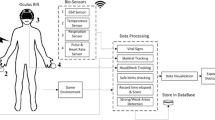Abstract
The principal objective of neural rehabilitation therapies is helping affected people to recover their mobility and reduce their dependency to other people in personal and occupational life. The way neural rehabilitation therapies are applied used to be based on the experience of the therapists and the epidemiological data available. Meanwhile, computer games (serious games), specially, based on virtual reality, are already used to treat exclusively certain types of phobia considering that an effective therapy consists on exposing patients to the source of their pathological fear within a controlled and safe environment. At present, at National Autonomous University of Mexico we are developing a set of applications based on videogames technology, programming them by the Unity SDK. The idea is helping patients to recover their mobility, which was lost by a neurological accident, or to confront their phobia. In this work we present the corresponding advances. In the case of neural rehabilitation, we focus the applications for ocular, head and neck recovery, developing some 3D scenarios for the Oculus Rift device. Respect to phobia treatment we consider attending arachnophobia, acrophobia and aviophobia, developing some 3D scenarios for Card Boards and also the Oculus Rift.
Access this chapter
Tax calculation will be finalised at checkout
Purchases are for personal use only
Similar content being viewed by others
References
Organización Mundial de la Salud. Discapacidades y Rehabilitación. http://www.who.int/disabilities/care/es/. Accessed 29 Sept 2018
United Nations: Convention on the rights of persons with disabilities. https://www.un.org/development/desa/disabilities/convention-on-the-rights-of-persons-with-disabilities.html. Accessed 29 Sept 2018
The World Health Report: 2001: Mental Health: New Understanding, New Hope (2001)
Medina, M., et al.: Prevalencia de trastornos mentales y uso de servicios: Resultados de la Encuesta Nacional de Epidemiología Psiquiátrica en México. Salud Mental 26(4), 1–16 (2003)
Vargas-Herrera, D., Brambila-Paz, F., Caldelas, I., Montufar-Chaveznava, R.: Exploring 3D scenes for neurorehabilitation. In: Fardoun, H.M., Ruiz-Penichet, V., Alghazzawi, D.M., Gamito, P. (eds.) 4th Workshop on ICTs for improving Patients Rehabilitation Research Techniques (REHAB 2016), pp. 77–80. ACM, New York (2016)
VirtualRehab. https://evolvrehab.com/virtualrehab. Accessed 30 Sept 2018
Virtual Reality: Kinect Rehabilitation. http://www.virtual-reality-rehabilitation.com. Accessed 30 Sept 2018
Reflexion health. http://reflexionhealth.com. Accessed 30 Sept 2018
Wiederhold, B.K., Bouchard, S.: Advances in Virtual Reality and Anxiety Disorders. Series in Anxiety and Related Disorders, 1st edn. Springer, New York (2014). https://doi.org/10.1007/978-1-4899-8023-6
Oculus Rift. https://www.oculus.com/rift. Accessed 29 Sept 2018
Google Cardboard. https://vr.google.com/cardboard. Accessed 29 Sept 2019
Metavision. https://www.metavision.com. Accessed 29 Sept 2018
Fove O. https://www.getfove.com. Accessed 29 Sept 2018
Vourvopoulos, A., Faria, A.L., Cameirão, M., Bermúdez i Badia, S.: Quantifying cognitive-motor interference in virtual reality training after stroke: the role of interfaces. In: Sharkey, P.M., Pareto, L., Broeren, J., Rydmark, M. (eds.) 10th International Conference on Disability, Virtual Reality and Associated Technologies, pp. 45–53. The University of Reading, Gothenburg (2014)
Garcia-Palacios, A., Hoffman, H., Carlin, A., Furness, T.A., Botella, C.: Virtual reality in the treatment of spider phobia: a controlled study. Behav. Res. Ther. 40, 983–993 (2002)
Trigo-Algar, A.R.: Serious games for overcoming phobias: the benefits of game elements. Master’s degree Project in Informatics. University of Skövde (2014)
Schmitt, W.J., Müri, R.M.: Neurobiologie der spinnenphobie. Schweizer Archiv für Neurologie 160(8), 352–355 (2009)
Bouchard, S., Côté, S., St-Jacques, J., Robillard, G., Renaud, P.: Effectiveness of virtual reality exposure in the treatment of arachnophobia using 3D games. Technol. Healthc. 14(1), 19–27 (2006)
Coelho, C., Waters, A., Hine, T., Wallis, G.: The use of virtual reality in acrophobia research and treatment. J. Anxiety Disord. 23(5), 563–574 (2009)
Hodges, L., Rothbaum, B., Watson, B., Kessler, G.D., Opdyke, D.: Virtual reality exposure for fear of flying therapy. IEEE Comput. Graphics Appl. 16(6), 42–49 (1999)
Acknowledgments
We thanks to the Dirección General de Asuntos del Personal Académico of the National Autonomous University of Mexico, through PAPIME for the support of the Project PE104416 “Ambientes Virtuales y Herramientas Digitales para Neurociencias” and PAPIIT for the support of the Project IT101917 “Realidad Virtual en la Visualización de Información Geográfica y Geofísica.”
Author information
Authors and Affiliations
Corresponding author
Editor information
Editors and Affiliations
Rights and permissions
Copyright information
© 2019 Springer Nature Switzerland AG
About this paper
Cite this paper
Vargas-Herrera, D., Oropeza, L.A., Cabrera, O.E., Caldelas, I., Brambila-Paz, F., Montúfar-Chaveznava, R. (2019). Exploring Virtual Reality for Neural Rehabilitation and Phobia Treatment. In: Fardoun, H., Hassan, A., de la Guía, M. (eds) New Technologies to Improve Patient Rehabilitation. REHAB 2016. Communications in Computer and Information Science, vol 1002. Springer, Cham. https://doi.org/10.1007/978-3-030-16785-1_4
Download citation
DOI: https://doi.org/10.1007/978-3-030-16785-1_4
Published:
Publisher Name: Springer, Cham
Print ISBN: 978-3-030-16784-4
Online ISBN: 978-3-030-16785-1
eBook Packages: Computer ScienceComputer Science (R0)




